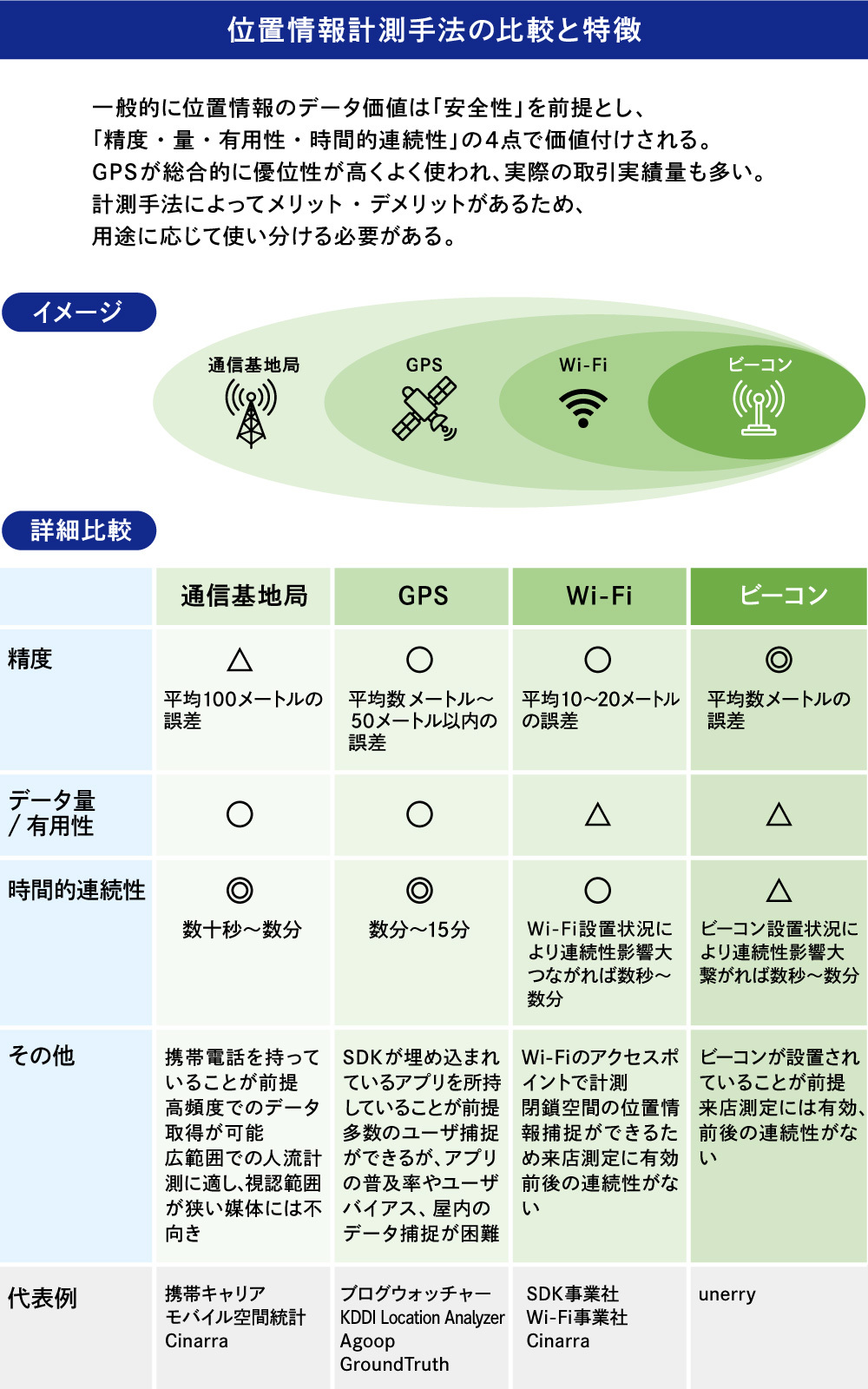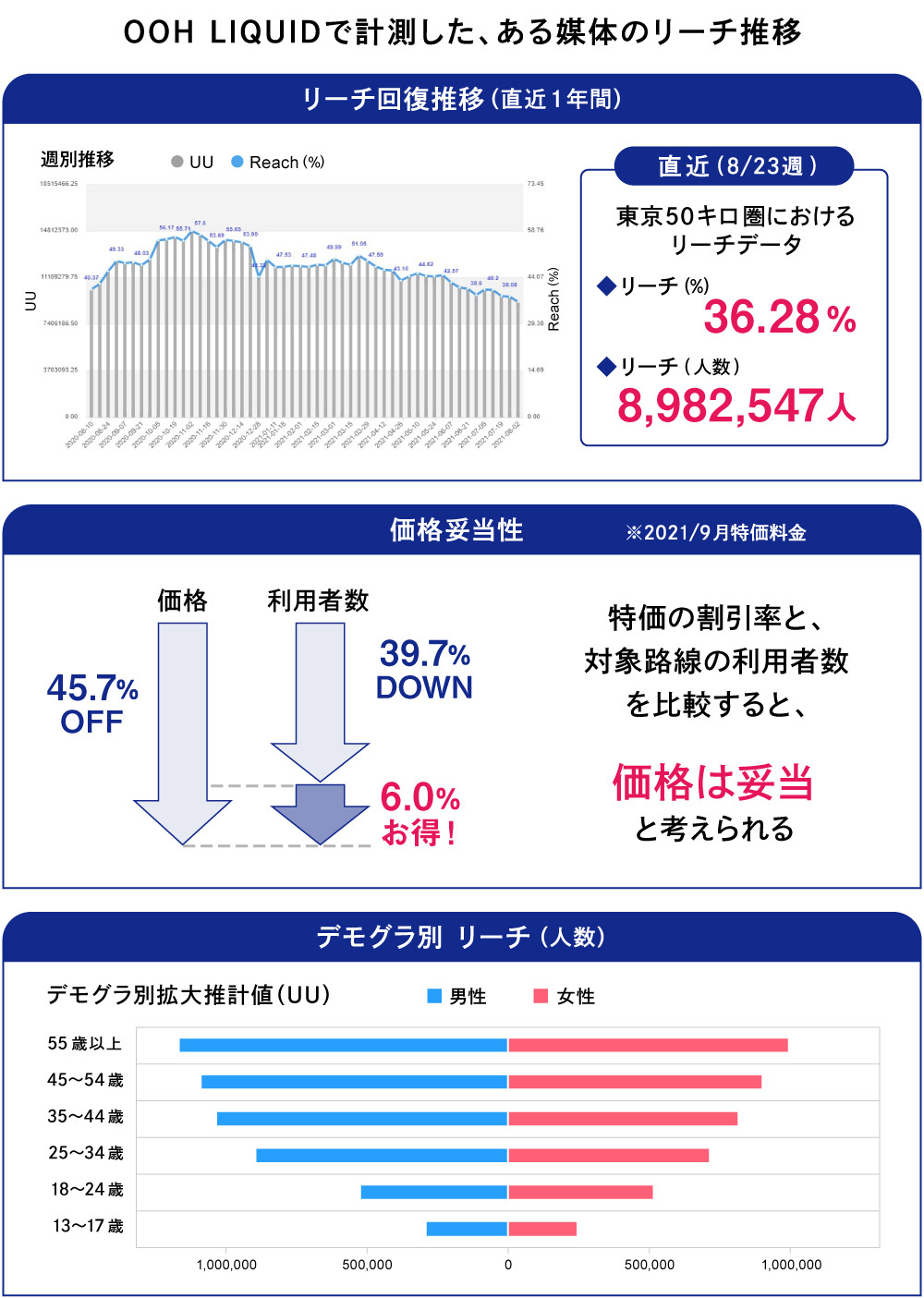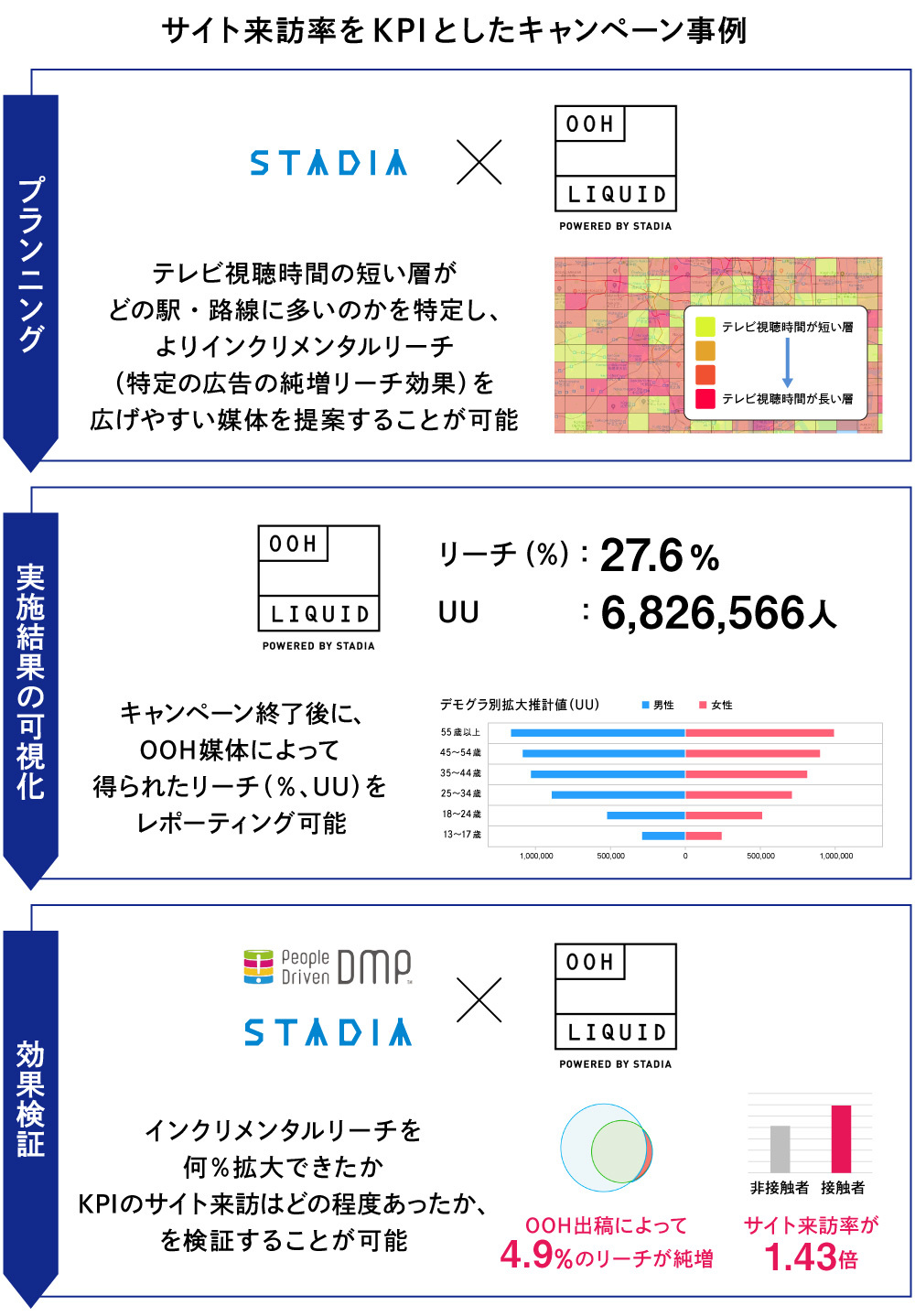Note: This website was automatically translated, so some terms or nuances may not be completely accurate.
Integrated Media Planning for OOH

As digital advertising becomes more prevalent, OOH (Out Of Home: outdoor and transit advertising) is increasingly required to undergo data-driven planning and effectiveness verification, comparing its advertising impact with other media. Furthermore, during the COVID-19 pandemic, advertisers have increasingly demanded media pricing and display effectiveness based on foot traffic data.
This time, we look back at the challenges OOH has faced, examine industry trends, and introduce Dentsu Inc.'s integrated planning approach combining multiple media such as TV, OOH, and digital.
Lack of Common Metrics for Measuring Advertising Value in the OOH Industry
For TV commercials, it's viewership ratings; for digital ads, it's impressions or clicks. Most advertising media allow confirmation after placement whether the expected exposure volume was achieved. However, OOH lacked such metrics for many years.
This is partly because OOH environments vary widely, with different sizes and contact scenarios per medium, making uniform evaluation difficult. The large number of domestic OOH media companies also contributed. It was challenging to consistently measure advertising value—specifically, who (the audience) saw the ad and how many times (impressions)—under a common metric across any period or medium.
The lack of a common metric covering all OOH led to a situation where, when advertising agencies recommended OOH to clients, they primarily relied on "experience-based knowledge" due to the absence of numerical evidence. This was particularly challenging from an integrated planning perspective, such as explaining the effectiveness of adding OOH to a campaign alongside TV and digital with numerical justification. Due to insufficient visualization of effectiveness, OOH was frequently excluded from media plans when proposing optimal media strategies within advertisers' overall media budgets.
OOH Industry Initiatives Toward Standardizing Advertising Value Metrics
To address the challenge of "no common metrics to measure OOH advertising value," various initiatives have been advancing in recent years.
Within the transit advertising sector, a system for estimating advertising reach based on the data from Video Research Ltd.'s SOTO/ex (a survey asking detailed usage patterns of routes, stations, and streets) has been operational since 2015. While progress has been made on common metrics, there is now a demand for cross-media common metrics encompassing other OOH formats.
Furthermore, in recent years, the number of companies providing location measurement services has increased. Utilizing this technology, efforts to establish audience measurement (measuring the number of individuals estimated to be within the screen's visible area, staying there, and viewing it under visible conditions) are progressing.

On February 10, 2021, the Japan Advertising Association launched the "OOH New Common Metrics Development Project" to enhance the value of OOH media. This project targets all OOH media, including both print and digital formats across transportation advertising, outdoor advertising, airport advertising, and taxi/bus advertising. Its goal is to establish new metrics that enable advertisers to conduct integrated, cross-media planning and compare planning and effectiveness with other media (particularly TV and digital) at the same granularity.
While the project's ultimate goal is to establish unified metrics aligned with international standards based on advertising value metrics, initial efforts focus on developing media visibility metrics for actual reach (actual) at the time of ad placement and preparing data to fully explain media effectiveness.
Furthermore, in March 2021, the Digital Signage Consortium announced its Audience Measurement Guidelines. These guidelines aim to visualize the effectiveness of DOOH (Digital Out Of Home: advertising utilizing digital signage), which has seen significant growth in recent years. Aligned with international standards, they outline recommended standard measurement methods for audiences, process checks, and benchmark guidelines.
OOH LIQUID: Planning and Effect Measurement Utilizing User Location Data
In December 2020, Dentsu Inc. developed "OOH LIQUID," a tool that analyzes the actual behavior of consumers exposed to OOH using smartphone app location data, enabling integrated media planning and effectiveness verification for OOH ( release details here ). This tool allows for the quantitative measurement of advertising effectiveness per OOH medium across two regions: Kanto and Kansai.
"OOH LIQUID" combines high-precision location data from GroundTruth, a U.S. location data company with which Dentsu Inc. has a capital and business alliance, with Video Research Ltd.'s survey results. This enables analysis of foot traffic at the media unit level (the menu items sold by media companies), verification of metrics like unique users and reach per media unit, creation of media plans, and verification of media effectiveness. Particularly during the COVID-19 pandemic, when foot traffic fluctuates daily, "OOH LIQUID" significantly contributes to advertisers' OOH planning decisions.
Additionally, Dentsu Inc. conducts a large-scale annual survey of approximately 40,000 people regarding their transportation usage. By capturing route usage and activity at major stations in the Kanto region, we can perform more accurate analysis and planning. We also utilize various foot traffic measurement tools tailored to specific advertising proposal needs.
By comparing the reach achievable through advertising placements to pre-pandemic levels, we can verify the reasonableness of OOH media companies' rates—whether they are overpriced or not. Having quantitative data allows us to evaluate OOH placements based on recent data, estimating the reach achievable for each OOH medium even during the pandemic.
Furthermore, we can retrospectively confirm the unique reach likely achieved during actual campaign periods. By utilizing GroundTruth's proprietary estimates of gender and age information, we can also verify reach by demographic group. This allows us to review not only overall reach but also reach by demographic segment when planning future campaigns.
*1 Demographics: Abbreviation for demographic. Demographics refer to population statistical attributes such as gender, age, residential area, income, occupation, and family structure.

Display the recovery trend of reach over a one-year period to estimate the number of people you can reach. You can also verify the effectiveness of special pricing (limited-time discounted prices) and the reach numbers for targeted demographics.
Integrated Planning Utilizing STADIA Data
OOH is sometimes combined with TV advertising as a reach supplement. Even for younger demographics or those with low TV viewing time—who TV ads struggle to reach—OOH can extend reach in metropolitan areas by capturing them during outings.
By utilizing Dentsu Inc.'s STADIA data (*2), we can understand the TV viewing habits of the target audience. This allows us to estimate which stations and lines have high concentrations of the target demographic and propose OOH placements in those areas. For effectiveness measurement, in addition to estimated reach, if the client's app allows for embedding ID tags beforehand, app downloads or website visit rates can also be used as campaign effectiveness metrics.
※2 STADIA: An integrated on/off-line solution that combines data from "offline" media (including TV) and "online" media (smartphones/PCs) to enable more effective marketing. As of June 2020, it holds viewing log data from approximately 5.8 million TVs, along with audience data comprising about 12 million mobile advertising IDs and roughly 120 million cookie IDs.

Furthermore, by utilizing the on/off integrated analysis platform "docomo data square™ (dds)" launched in 2020, we can also measure effectiveness using Docomo's d-pay and d-point data, with "purchases" as the KPI. Previously, there was no data platform capable of integrating and analyzing TV, digital, and OOH across three media. The key feature now is the ability to verify effectiveness at the individual ID level, including OOH. Case studies utilizing dds are featured in a series in the Dentsu News, so please refer to it for more details.
As introduced, the OOH industry is initiating efforts in audience measurement and effectiveness measurement to advance integrated planning across these three media. Dentsu Inc. has developed OOH LIQUID, a new solution enabling quantitative estimation and visualization of diverse data. Additionally, we have established a system utilizing STADIA data to plan OOH placements based on viewing trends and measure their effectiveness.
While OOH has traditionally relied heavily on intuition and experience, incorporating quantitative data into placement decisions may become the new normal.

Was this article helpful?
Newsletter registration is here
We select and publish important news every day
For inquiries about this article
Back Numbers
Author

Kana Misawa
Dentsu Inc.
Out-of-Home Media Division
After working in creative, sports business, AI chatbot, and healthcare business development, he assumed his current position. He is involved in developing media planning tools centered on OOH and business development in the data and technology domain. Ph.D. (Interdisciplinary Information Studies)



